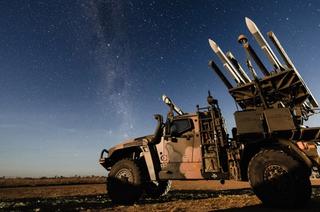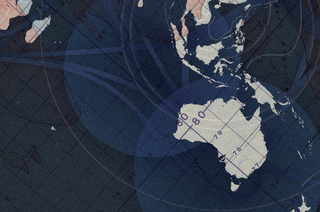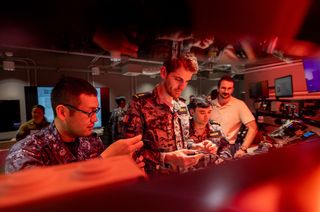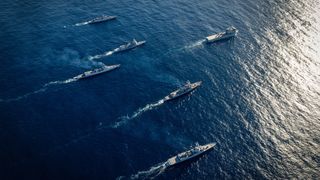Executive summary
- Maritime domain awareness (MDA) is essential for states in preserving national security, protecting economic interests and managing broader maritime assets and resources more effectively. MDA involves the collection, analysis and dissemination of data regarding maritime activities, enabling states to better respond to threats, monitor illegal activities and coordinate maritime operations. Enhancing MDA can provide a number of significant maritime advantages for states, including improved safety, better environmental protections and ensuring maritime trade safely reaches its intended destinations.
- In a region characterised by increasing insecurity and geopolitical competition, many states in the Indian Ocean region (IOR) face significant challenges in effectively developing their respective MDA capabilities. These challenges can include limited resources, a lack of technological infrastructure and insufficient training, often compounded by inadequate coordination among regional stakeholders. Cooperation could help to significantly mitigate these constraints. As a result, many IOR states’ ability to monitor maritime activities within their own maritime jurisdictions, respond to emerging threats, and preserve their security and economic interests more broadly is inadequate or compromised.
- Australia, India and the United States represent three of the most MDA-capable nations in the IOR. Trilateral maritime cooperation between the three countries offers a promising grouping for addressing mutual maritime security challenges in the IOR. They all share a common operational platform for MDA — the P-8 Maritime Patrol Aircraft (MPA) — and possess a shared interest in preserving a stable and prosperous Indian Ocean where nations can freely trade and pursue efforts conducive to economic development and shared prosperity.
- Indeed, Australia, India and the United States have recognised the advantages of more networked security cooperation and have increasingly taken steps to collaborate on defence and security initiatives within the IOR. In recent years, this has included joint exercises, information sharing and technological cooperation, all key components of a growing trilateral relationship. Collectively, these efforts aim to enhance regional stability, counter maritime threats, and improve collective response capabilities to promote freedom of navigation and economic prosperity in the IOR.
- Coordinated operation of the P-8 aircraft presents a significant opportunity for Australia, India and the United States to spearhead their broader, but still siloed and sporadic efforts at enhancing trilateral MDA in the Indian Ocean. Enhanced P-8 cooperation and the information-sharing that would be required to support such efforts would prove instrumental to wider MDA efforts such as intelligence cooperation, improving surveillance capabilities and strengthening operational readiness.
Trilateral maritime cooperation between Australia, India and the United States offers a promising grouping for addressing mutual maritime security challenges in the Indian Ocean region.
Recommendations
Australia
- Promote expanded trilateral P-8 deployments and exercises that incorporate surveillance, information sharing, and broader intelligence, surveillance and reconnaissance (ISR) operations addressing grey zone threats.
- Invest in regional Information Fusion Centres (IFCs) to enable more timely and structured delivery of actionable intelligence across the IOR, helping position Australia as a vital regional information-sharing hub.
- Accelerate upgrades to Cocos (Keeling) Islands airfield to leverage the island’s strategic location to serve as a forward operating base for trilateral P-8 operations and joint patrols.
India
- Support expanded trilateral training by hosting regular trilateral exercises, involving P-8 platforms, focused on anti-submarine warfare and enhancing real-time MDA coordination.
- Champion regional MDA capacity-building to encourage and facilitate other regional navies and maritime agencies into coordinated MDA frameworks, including structured engagement through IFCs.
- Enable selective intelligence sharing protocols to allow the timely dissemination of non-sensitive intelligence via IFCs to regional partners.
- Operationalise and integrate INS Jatayu (Minicoy), INS Baaz (Andamans) and the Agaléga Island base into trilateral P-8 operations to ensure persistent coverage of strategic chokepoints and important sea lines of communication.
United States
- Support IFC capability development to improve data fusion, dissemination and real-time responsiveness of regional IFCs, enabling more effective use of relevant US intelligence capabilities.
- Institutionalise trilateral interoperability initiatives, moving ongoing P-8 cooperation from their current ad hoc format to more routinised and structured coordination.
- Facilitate incremental intelligence transparency by encouraging the improved sharing of non-sensitive ISR data, helping pave the way for more enhanced defence intelligence sharing.
- Maximise Diego Garcia’s utility in trilateral operations to reinforce a trilateral strategic presence in the central IOR that will prove significant to broader Indo-Pacific deterrence.
Trilateral efforts
- Standardise procedures and protocols for joint P-8 operations, including data-sharing standards, coordinating the frequency and scope of deployments, and operational planning.
- Create a shared digital MDA platform or dashboard accessible to the three countries and selected regional partners, hosted through IFCs or regional operations centres.
- Establish a trilateral P-8 coordination cell to synchronise mission planning, execution and post-mission assessments.
Introduction
Maritime Domain Awareness (MDA) is essential for all littoral states, whether island nations or those with continental shorelines, and even for landlocked countries that rely on maritime trade routes.1 MDA supports both strategic and operational decision-making across the economic and security spheres. In the Indian Ocean region (IOR), however, the sheer expanse of the maritime domain, coupled with the developmental challenges faced by many regional states, often results in fragmented or inadequate approaches to supporting MDA activities. Strengthening the capacity to collect, analyse and act upon diverse maritime data — the foundations of MDA — is therefore vital to enhancing the IOR’s economic security and prosperity.
One platform that could provide an instrumental means in supporting such efforts is the Boeing P-8, a highly capable, multi-mission maritime patrol aircraft (MPA). Designed principally for long-range anti-submarine and anti-surface warfare, its advanced sensors and mission systems also make it highly suited to intelligence, surveillance and reconnaissance missions. The Boeing P-8 is a platform operated in the Indian Ocean by three of the most MDA-capable countries in the region — Australia, India and the United States. While Australia, India and the United States have recognised the advantages of pursuing more networked security cooperation and have increasingly undertaken steps to collaborate on defence and security initiatives within the Indian Ocean region, coordination on P-8 operations has yet to emerge as a central feature of the three countries’ security cooperation. This policy brief explores the important role of MDA in upholding maritime security and why enhanced trilateral cooperation on this platform represents a critical first step to advancing defence ties between Canberra, New Delhi and Washington.
The role of maritime domain awareness
According to the International Maritime Organization (IMO), “Maritime domain awareness is the effective understanding of anything associated with the maritime domain that could impact security, safety, the economy or the marine environment.”2 Identifying and understanding events taking place in the maritime environment is a fundamental capability required for states, especially littoral nations, and their defence forces before any consideration of their ability to respond to threats can be undertaken.
Comprehensive and effective MDA is a chronic challenge, not just for developing countries but also for larger economies, particularly in the Indian Ocean region, given its especially vast geographic expanse.
The Indian Ocean is one of the most industrious maritime regions in the world. Three of the world’s five most significant maritime trade routes lie within the IOR; almost 90,000 vessels carrying 9.84 billion tonnes of cargo travel through its choke points to ports in Africa, Asia, Europe and Australia.3 It is a region comprising 39 individual states4 and it attracts the strategic interest of the world’s major powers.
Figure 1. World shipping lanes
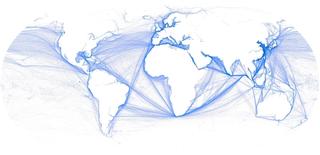
With sometimes limited land mass but extensive Exclusive Economic Zones (EEZs), many nations in the IOR rely upon their maritime territories for economic, energy and food security. However, these island and littoral states often have limited capacity to police jurisdictions that are increasingly subject to a variety of maritime threats, adverse climate events, illegal resource exploitation and tensions caused by the growing strategic competition between China and the United States.
States in the Indian Ocean — a maritime domain distinguished by its vastness and compounded by insufficient regulation — are particularly susceptible to crime from non-state actors. Transnational maritime crimes, including piracy, illicit trafficking of people, drugs and weapons are prevalent in the region. Rather than abating, these illegal activities have surged in recent years due to a culmination of factors that include dwindling national fisheries, reduced coastal welfare and a weakening rule of law.5
Climate disasters, including hurricanes, tropical cyclones and storms, also increasingly threaten the livelihoods of small states in the Indian Ocean. In 2022, the 6th Intergovernmental Panel on Climate Change released its assessment that the Indian Ocean is warming at a higher rate than other global oceans, with the sea level around Asia increasing faster than the global average and changes to monsoonal weather patterns leading to a likely increase in tropical cyclone intensity.6 A series of severe weather events could significantly reduce the economic and social resilience of some IOR communities, leaving them more vulnerable to rising sea levels or heightened food insecurity. This could further exacerbate the risk of large-scale human displacements and political instability, already exemplified in countries such as Bangladesh and the Maldives.
Despite the increased availability of low-cost sensors, many Indian Ocean nations are unable to adequately identify threats in the maritime environment, whether natural or man-made.
MDA is, therefore, a foundational element of maritime security — preceding even the ability to respond to threats. A secure and stable maritime environment underpins the free and open use of the seas as a global commons. For regional powers with both the capacity and intent to foster mutually beneficial partnerships, contributing to MDA and associated information-sharing should be a strategic priority. Such efforts not only enhance regional security in their own maritime spheres but also strengthen the ability to support smaller and less resourced partners across the region.
Despite the increased availability of low-cost sensors, many Indian Ocean nations are unable to adequately identify threats in the maritime environment, whether natural or man-made. They are consequently often incapable of preventing the illegal exploitation of their maritime resources, securing their maritime trade or combating other illegal maritime activity in their jurisdictions. Too often, the only thing preventing the realisation of such equities is a lack of capability on the part of smaller nations.
Strategic competition in the Indian Ocean region
The establishment of China’s Belt and Road Initiative (BRI) in 2013 saw a rapid increase in funding for Chinese maritime infrastructure projects across the region, from ports in Southeast Asia to Djibouti on the east coast of Africa. China is rapidly developing the world’s largest blue-water navy, and over the past decade, has seen China significantly increase its presence and influence in the Indian Ocean region. For more than a decade, the People’s Liberation Army Navy (PLAN) has increased its maritime presence across the IOR (see Table 1) with more frequent naval deployments and visits to ports in Pakistan, Sri Lanka, Bangladesh and the Maldives, it has intensified joint military exercises with partners in the region and boosted sales of arms and defence equipment to a number of regional countries.7 China’s rapid development of its naval capability in both the Indian and Pacific Oceans is seen by many as a direct challenge to the United States’ military presence in both regions. In the Indian Ocean, this has been made more complex by the interests and efforts of other powers such as India and even Russia, which seek to advance their strategic interests in the region.8
Table 1. Timeline of significant PLAN activities in and around the Indian Ocean, 2015-20249
The PRC’s demonstrated willingness to use force to coerce its neighbours in pursuit of economic and territorial claims in the South China Sea is leading to anxiety and concerns on the part of other regional states. China has been undertaking more frequent ‘grey zone’ activities in the IOR, often with apparent disregard for longstanding international norms and the codified Law of the Sea.10 Countries often face resource theft from technically more advanced or numerically superior Chinese vessels. Further east, Chinese vessels have even engaged in violent clashes in areas like the West Philippine Sea.11 China’s actions in the IOR have exhibited somewhat different characteristics than those in the disputed territorial claims of the South China Sea — notably lacking the overt aggression and belligerence demonstrated in waters over which it makes its disputed territorial claims. In the IOR, China tends to focus on the use of ‘spy ships’ and illegal, unreported, and unregulated (IUU) fishing by its distant water fishing fleets (themselves often part of China’s maritime militia, fitted with high tech intelligence-gathering sensors and used to cause conflict and disruption without using ‘state’ vessels).12 This activity is received with serious concern among many nations of the region, particularly India, for whom such ships represent a security and economic threat.13 While Australia and the US have focused their resources and attention primarily on the South China Sea and Chinese activities near the sea lines of communication between Southeast and North Asia, India has naturally had a much greater concentration on the IOR.14 This is also something that Australia and the United States will need to pay greater attention to as they prepare nuclear submarines for long-distance operations once Australia acquires US nuclear-powered Virginia-class submarines in the 2030s.
China’s military expansion and aggressive actions across the Indo-Pacific strike deep concern for many of the smaller states in the region, driving countries to seek like-minded partners to provide some degree of collective security. In October 2024, Commodore Jay Tristan Tarriela of the Philippine Coast Guard, travelled to Australia as a special envoy of Filipino President Ferdinand Marcos Jr. to highlight the strategic necessity of addressing Chinese maritime activities in the West Philippine Sea. He also underlined that it had been a challenge to garner support in exposing China’s aggressive actions from other ASEAN member countries.15 As a result, in November 2023, President Marcos, stated that due to China’s “coercive tactics and dangerous manoeuvres” in the South China Sea, Manila would partner with Washington and other regional nations to come to some form of solution to maintain the peace.16 This subsequently led to a significant increase in base access, joint exercise training and weapons transfers with the United States under both the Biden and second Trump administrations.17
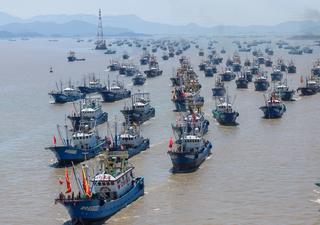
Other countries in the Indian Ocean region are also strengthening their regional and international partnerships accordingly. While a number of smaller IOR states are wary of binding with great powers, they are nevertheless increasingly receiving opportunities to do so, such as through China’s ‘Belt and Road Initiative’. According to the Lowy Institute’s Asia Power Index, the United States retains an extensive advantage over China in terms of its alliance network, with key treaty allies encompassing Australia, Japan, South Korea, and the Philippines.18 The United States is supplying more and more military hardware to the Indo-Pacific already demonstrating significant increases in defence spending.19 While not a formal ally, the United States is also bolstering its bilateral relationship with India to such an extent that New Delhi is now Washington’s leading military exercise partner, conducting more exercises and personnel exchanges than any other country in the world.20
Australia, too, is becoming increasingly closer to countries in the Indian Ocean region by enhancing its engagement with ASEAN and taking part in maritime exercises and operations with regional partners.21 As Australia continues to expand and sophisticate its maritime presence in the IRO, it will need to more critically assess its engagements in an increasingly complex region to ensure that Canberra’s partnerships and collaborative efforts do not culminate in alignments counterproductive to Australia and the interests of its close partners. Amidst growing great power strategic competition, Australia’s position as a middle power may work in its favour. Smaller regional players may view the state as a less threatening partner, working towards addressing shared maritime challenges in the region.22 This provides Australia with an opportunity to lead initiatives to build regional security cooperation, which it has sought to do through avenues such as the Indian Ocean Rim Association (IORA) and the Indian Ocean Navy Symposium (IONS).
As Australia continues to sophisticate its maritime presence in the IRO, it will need to more critically assess its engagements in an increasingly complex region to ensure that Canberra’s partnerships and collaborative efforts do not culminate in alignments counterproductive to Australia and the interests of its close partners.
India, which now sits in the front rank of Australia’s and the United States’ international partnerships due, in large part, to their shared security interests, is particularly concerned by the stability and openness of the Indian Ocean. New Delhi seeks to remain the pre-eminent maritime power among Indian Ocean countries, and while it has undoubtedly moved closer in its security cooperation with the United States, Australia and other partners, it maintains such relationships as partnerships rather than formal alliance commitments.23
Existing MDA arrangements in the Indian Ocean region
If MDA is critical to the stability and openness of the Indian Ocean, which is crucial to addressing the tensions generated from crime at sea and great power rivalry in the region, then current IOR arrangements for sharing information are clearly inadequate. Current arrangements are varied and largely undertaken on an ad hoc basis with little real operational benefit, requiring refinement, improvement and supplementation if they are to be leveraged effectively.
Currently, the IOR boasts a number of Information Fusion Centres (IFCs), including in Singapore, New Delhi and Madagascar. These centres are intended to serve as concentrations of maritime domain awareness in the region and are staffed by International Liaison Officers, generally from the navies or coast guards of participating partner nations.24
These IFCs use a collaborative approach to enhance information sharing and coordination to bolster national response capabilities. Liaison Officers act as information conduits for operation centres in their own defence headquarters to share information amongst partners. They also collaborate with regional entities such as the Indian Ocean Commission (IOC) and other maritime fusion centres globally, but the information provided to members and relevant agencies in the region is often incomplete or not timely.25 The centres monitor maritime traffic, generate security updates and provide a maritime situational picture. However, their effectiveness is often undermined by having to rely on outdated data, as summary reports of maritime incidents and issues are released on a monthly or quarterly basis.26 These timescales mean it is too late for regional military or maritime constabulary forces, which require real-time data and intelligence, to take appropriate and effective action.
Figure 2. Map of fusion centres in the Indian Ocean region
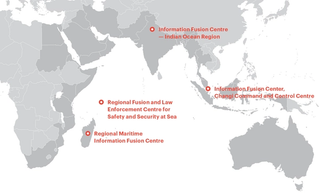
Countries in the region also share information through various bilateral information-sharing agreements. For example, the India-US White Shipping Agreement, signed in May 2016, enhances the two countries’ respective maritime domain awareness capabilities in the Indian Ocean region by developing technical arrangements for data sharing on commercial maritime traffic.27 This arrangement is analogous to a 2015 agreement signed between India and Australia that similarly share white shipping information and a 2002 Security of Information Treaty between Australia and the United States.28 Information is also shared in the region through inclusive regional mechanisms, including those attached to the Indian Ocean Rim Association (IORA), particularly with respect to countering transnational terrorism and disaster risk management. In 2017, IORA, the most senior and authoritative multilateral grouping of Indian Ocean states, highlighted the fundamental need for intelligence-sharing capabilities amongst members, proposing a regional surveillance network to include sharing of maritime data and exchange of information on maritime transportation systems. However, critical among the faults of existing arrangements is the lack of real-time intelligence, which limits or even negates the ability of regional states to respond effectively and in a timely manner to threats and other maritime incidents. Such delays can be critical, even fatal. There are also a number of more sensitive information sharing arrangements in the region but the nature of the information shared and the agreements themselves are classified.
The response: Maritime patrol and the P-8 Poseidon
Australia, India and the United States have national security policies that identify the need for enhanced MDA in the Indo-Pacific region among their key strategic priorities.29 This strategic interest relates not only to addressing the threat of military conflict in their region but also to ensuring freedom of navigation and the free flow of commercial shipping. Accordingly, efforts to develop trilateral cooperative approaches that support an enhanced regional MDA capability not only serve the individual interests of the three powers but, importantly, also serve the interests of other regional states.
India, Australia and the United States are also arguably the most MDA-capable nations in the region. The three nations have advanced, integrated national systems that include satellite imagery, radar and a variety of manned and unmanned sensors. Prominent among these systems is the Boeing P-8 maritime patrol aircraft (MPA) operated by all three countries.
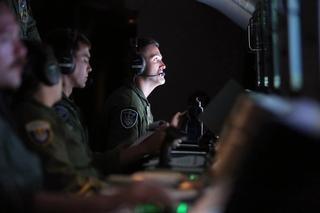
Based on the commercial Boeing 737 airframe, P-8 aircraft have exceptional range (7,500km), endurance and speed (907km/hour).30 Though India, Australia and the United States operate different variants of the aircraft, all are equipped with advanced sensors and mission systems, including an integrated sensor suite that enables the aircraft, in addition to submarine detection, to detect, track and interdict a variety of surface targets.31 P-8s are also used to good effect throughout the region for low-altitude humanitarian and search and rescue missions, activities that offer non-contentious benefit to other states in the region.
The P-8’s ability to operate in conjunction with other maritime assets means that the aircraft is particularly well-suited for conducting extended joint surveillance missions over vast maritime areas. The ease of achieving interoperability with allied and partner forces further enhances the potential for cooperative engagement.
National Operation of the P-8
India
It is unsurprising that India views the security of the Indian Ocean both as a national strategic imperative and an obligation as the resident power in the region. As India’s Prime Minister Narendra Modi said concerning his Country’s SAGAR policy:32
India is becoming more integrated globally. We will be more dependent than before on the ocean and the surrounding regions. We must also assume our responsibility to shape its future. So, Indian Ocean Region is at the top of our policy priorities. Our vision for Indian Ocean Region is rooted in advancing cooperation in our region; and, to use our capabilities for the benefit of all in our common maritime home.
The Indian Navy operates the Boeing P-8I Neptune variant for maritime reconnaissance and anti-submarine warfare missions. With 12 aircraft, it undertakes surveillance of much of the northern Indian Ocean with P-8Is based at INS Rajali, near Chennai, INS Hansa in Goa and importantly, INS Baaz in the Andaman and Nicobar Islands, located at the Indian Ocean end of the Malacca Strait. These islands are a gateway to the South China Sea and represent a potential strategic choke point for the Chinese Navy. Indian P-8s are also increasingly using facilities of regional partners such as Seychelles, Mauritius and the French island of La Réunion.34
Australia
The Royal Australian Air Force (RAAF) operates 12 Boeing P-8A Poseidons (with four more on order) from RAAF Edinburgh, 25 kilometres north of Adelaide in South Australia. This location is particularly suitable for anti-submarine operations in the Southern Ocean. The P-8s contribute to Australia’s whole of government effort to protect Australia’s borders and offshore maritime interests.35
The aircraft has significantly bolstered the RAAF’s ability to protect Australia’s maritime interests and support regional security initiatives. Under Operation Gateway, RAAF P-8s regularly deploy across the region from RAAF Butterworth in Malaysia, patrolling some of the world’s busiest shipping routes in the northern Indian Ocean and South China Sea. The RAAF has also undertaken maritime surveillance missions through the South China Sea from Singapore.36 RAAF P-8s also participate in international maritime operations. For instance, in 2022, they operated as far away as the Mediterranean in support of NATO’s Sea Guardian mission.37
The United States
Not surprisingly, the United States has the greatest number of P-8s, with Boeing having delivered 117 P-8A Poseidons to the US Navy by March 2023.38 The aircraft operate from a number of bases around the continental United States and Hawaii and periodically conduct operations out of US airbases in Guam and the strategic naval support facility at Diego Garcia in the Indian Ocean. The US Navy has also operated from the territories of regional partner countries, including Japan, Singapore and Thailand.39 The P-8s contribute significantly during major US Navy deployments, playing a crucial role in maritime patrol and reconnaissance missions. Their ability to deploy as a part of its Navy’s fleet deployments to and from key strategic airfields within the Indian Ocean region means that they offer highly flexible and effective intelligence gathering capabilities, and their crews and technical equipment make them valuable in developing a comprehensive maritime domain picture for analysis and response.
Developing the building blocks for enhanced trilateral cooperation
Bilateral security engagement between the United States and Australia has been a cornerstone of Australia’s national security strategy, replacing Britain as Australia’s key strategic partner since the Second World War. India and Australia have common interests; both countries are democracies interested in preserving a rules-based order in the Indian Ocean (a common border between the two countries) and share a common heritage as members of the British Commonwealth. Deep people-to-people ties are embodied in an 850,000 strong Indian diaspora community in Australia.40 Not to mention, bilateral defence cooperation is a core pillar of the Comprehensive Strategic Partnership signed by the leaders of Australia and India in 2020.41 As such, Australia represents an attractive strategic partner for an Indian Government endeavouring to preserve its non-alignment ethos by avoiding formal alliance with a global power. Australia provides a relevant middle power option that is capable and effective. India and the United States are also becoming increasingly close. People-to-people ties are underpinned by a significant Indian diaspora population in the United States, with over five million people of Indian descent currently residing in the country.42
The conflict between India and China in Ladakh, as well as China’s support for Pakistan and its development of ports and other maritime infrastructure in countries surrounding India, has highlighted to New Delhi that it cannot act alone in maintaining security in the Indian Ocean. India needs to develop its strategic relationships to counter Chinese influence in the region. Despite the ‘Make in India’ strategy — an initiative to promote self-reliance and technological capability by restricting government purchasing to Indian-made products, particularly defence hardware — of the Modi government, India is also now purchasing critical military equipment from the United States (and other countries) or partnering with them to develop necessary defence systems.43 In part to ameliorate the risks and detriment of being too closely dependent upon a single capability provider,44 India now seeks to fill specific capability needs and to acquire technology to support and develop its own defence industry from a number of providers, including existing platforms such as the P-8s and the possible future transfer of F-16 fighter jets.45
Australia, India and the United States already undertake an array of cooperative defence and security activities, including military exercises, combined operations, training and technology transfers and information sharing. While these activities have principally been undertaken on a bilateral basis, there is recognition of the benefits in expanding such efforts to include relevant third parties, with an increasing appetite to invite participation in previously bilateral exercises and exchanges. This development has been clearly demonstrated over recent years:
- In September 2024, at the invitation of India, RAAF participation took place for the first time during Exercise Tarang Shakti, the Indian Air Force’s fast jet exercise.46
- A 2022 invitation from the US for Australia to observe or potentially participate in Exercise Yudh Abhyas, its bilateral high-altitude mountain training activity with the Indian Army.47
Senior officials in each country have highlighted the importance of mutual cooperation between their respective countries, labelling each of the others as a “top tier security partner” advocating, if not mandating, enhanced security engagement and defence collaboration. Most recently, in the visit to Australia by General Anil Chauhan, Indian Chief of Defence Staff (marking the first ever visit to Australia by an Indian CDS).48 The Quadrilateral Security Dialogue or the Quad, and including Japan, is another example of the strategic ties that bind the three countries in the interest of reaffirming their “shared commitment to strengthening a Free and Open Indo-Pacific where the rule of law, democratic values, sovereignty, and territorial integrity are upheld and defended.”49
Although dedicated Australia-India-United States trilateral initiatives are currently limited, the appetite for trilateral partnership is growing in scope and complexity.
Although dedicated Australia-India-United States trilateral initiatives are currently limited, the appetite for trilateral partnership is growing in scope and complexity. The foundations for their development are already taking place through the three countries’ participation in existing multilateral defence events. This includes the active participation of all three countries in joint air and ship patrols and operations, as seen during recent iterations of the ADF’s Indo-Pacific Endeavour, Australia’s flagship regional engagement activity; the participation of an Indian Navy P-8I in Exercise Kakadu 2024, Australia’s largest maritime warfare exercise; and, most notably, through Australia’s first-ever hosting of Exercise Malabar off the coast of Sydney in 2023.50
The growing need for trilateral P-8 engagement
Though Australia-India-US coordination of P-8s is not yet regularised, the operation of this common platform provides abundant opportunities for cooperative engagement. Based on shared understandings and experience, this undertaking would be comparatively simpler to coordinate than other forms of maritime cooperation and offers significant MDA benefits.
First, at the strategic level, such coordination sends a clear signal of common intent and a tangible demonstration of a shared resolve; it offers a highly effective demonstration of combined capability and sends a strong message regarding the importance of developing military ties and combined strength with other powers to ensure a favourable balance of regional strategic and military power.
At the tactical and operational levels, trilateral P-8 engagement offers the ability to share lessons learned, to improve efficiency, and to identify effective methods and best practices for overcoming challenges.
At the tactical and operational levels, trilateral P-8 engagement offers the ability to share lessons learned, to improve efficiency, and to identify effective methods and best practices for overcoming challenges. It aids the development of mutual understanding and facilitates interoperability, improving the ability to work together in parallel or in concert. Trilateral P-8 engagement builds trust and mutual support, developing relationships between the three countries’ military commands across all levels of the force spectrum. It also presents an opportunity to address resource constraints, allowing access to a wider pool of P-8 capability to ‘share the load’ of a complex and extensive reconnaissance tasking responsibility.
Structured, coordinated cooperation at the operational level has not yet materialised for various reasons. This has been partly a result of India’s deeply held concerns about alignment, but also largely due to broader concerns among the three countries regarding information sharing and issues of trust concerning sharing sensitive information about military technology, mission plans and the operational precision of the information gathered from such missions. However, these concerns have been successfully addressed during recent bilateral operational and training engagements between the three nations. As such, the appetite for MDA cooperation has in the past been restricted but is clearly growing with recent engagements including joint patrols and combined training, information exchanges and reciprocal air riding of personnel in each other’s aircraft.51
Table 2. Notable bilateral and Australia-India-US trilateral defence training activities involving P-8 maritime aircraft, 2018-202452
While Australia and the United States have undertaken trilateral training with Japan, they have not yet directly undertaken it with India via a trilateral framework. This would represent a more palatable ‘crawl-walk-run’ approach towards their developing trilateral cooperation before moving to more complex combined operations.
Future prospects
Australia, India and the United States all have formally agreed Mutual Logistics Support Agreements designed to enable enhanced military interoperability, facilitate increasingly complex military engagement and greater combined responsiveness to regional issues. These have been used to support national maritime and air deployments, though only sparingly since being signed (2020, in the case of Australia and India, 2016 in the case of India and the United States, and 1989 in the case of Australia and the United States).53 However, expanding upon these to support combined trilateral P-8 operations is unnecessary.
To be sure, existing agreements are already in place that can help support these efforts. Australia and the United States have Enhanced Air Cooperation (EAC) and Enhanced Maritime Cooperation (EMC) strategies to deepen integration and facilitate seamless operations to deliver improved security and stability.54 These agreements also provide increased opportunities to enhance bilateral engagement with regional partners through involvement in relevant exercises and training activities. These strategies improve Australia and the United States’ maritime domain awareness, however there would be a significant benefit to including India in such accords, either by expanding the existing terms or developing new agreements to further extend the benefits they provide. More noticeably, a trilateral agreement or shared agenda between the three countries would ultimately demonstrate resolve on shared maritime challenges where enhancing closer cooperation would prove instrumental and send a strong message to the region.
Apart from trilateral information sharing, there is also a need to address the delivery of real-time intelligence data to regional partners. While again, submarine (and perhaps some surface asset) data may be excluded from information sharing protocols due to the sensitivity of the collection methodology, there needs to be a more structured and, most importantly, timely mechanism for the delivery of information to relevant parties. This could represent a new and valuable role for the regional Information Fusion Centres to undertake, one that would significantly increase the importance of these centres and their value to the region. These centres already have direct contact with each other and other regional national operations centres. A useful capability development investment might be made to improve the timeliness, efficiency and coverage contact between centres to ensure that mechanisms exist to provide actionable intelligence across the region.
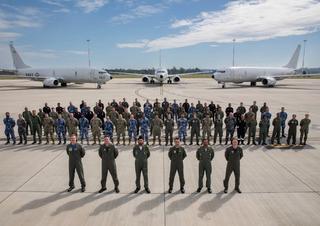
Due to their strategic locations, the airfields that provide the greatest potential for effective operational impact are all islands:
- The US Navy Support Facility Diego Garcia, located at 7 Degrees South Latitude off the tip of India, provides the United States with a presence in the Indian Ocean within reach of the Persian Gulf.
- The new Indian naval base, INS Jatayu, on Minicoy, the southernmost island in India’s Lakshadweep archipelago, lies about 130 kilometres north of the Maldives and straddles key trade routes.
- INS Baaz in the Andaman and Nicobar Islands, located at the Indian Ocean end of the Malacca Strait, is a gateway to the South China Sea.
- The new Indian naval base on Agaléga Island of Mauritius.
- Australian bases in Western Australia and Darwin pending the completion of upgrades to the airfield on Cocos (Keeling) Islands, Australia’s external territory located approximately 3,000 kilometres north-west of Perth, Western Australia.
The United Kingdom also operates the Boeing P-8, but, unlike the Australia-India-United States triad, the Australia-UK-United States partnership, under AUKUS, has managed to develop a trilateral agreement to share P-8 sonobuoy data — one of the first AUKUS Pillar II initiatives to be implemented since the announcement of the partnership in 2021.55 India is currently excluded from that agreement due to the sensitivity of the platforms themselves, the technical equipment on board and the nature of information produced through operational deployments.56 While combat systems’ integration may be required to ensure the ability to identify and track Chinese submarines in the region and perhaps even to “fight as a blended force”, that objective is still a distant prospect.57 There are elements of trust and security that still need to be worked through to make that happen. Sharing submarine data may currently be seen as a step too far, but sharing other forms of data — environmental, criminal or even foreign grey shipping — still represents ‘interoperability’ and may be offered through working together to identify critical elements of MDA, if not yet the whole picture. Such data sharing offers a step towards building that trust.
Once proven in concept, additional partners could be added, extending the arrangement to include other countries with significant MPA capability in the region. These efforts could ultimately benefit from the inclusion of other non-P-8 Maritime assets, including French deployments of the Atlantique MPA out of its airfields on La Réunion in the western Indian Ocean, or Japan’s deployment of the Kawasaki P-1. While some benefits might be forfeited from the lack of commonality of platforms, there would still be lessons to be learned, regional MDA capabilities would be advanced, and signalling would be even stronger. Japan, particularly, as an existing member of the Quad, would be a logical and straightforward addition. The Quad may not have an explicit security mandate — indeed some partners may argue that it inherently does not — but, as reflected during the latest Quad Foreign Ministers’ Meeting in Washington in January 2025, there has been a definite effort to enhance security cooperation, with a clear focus on enhancing capability, interoperability and readiness.
As a result, Australia, India and the United States should attempt to implement national and, where possible, potential trilateral efforts, including:
Australia
- Promote expanded trilateral P-8 deployments and exercises. Initiate regular, coordinated P-8 missions with India and the United States that incorporate surveillance, information sharing, and broader intelligence, surveillance and reconnaissance (ISR) operations targeting grey zone threats.
- Invest in regional Information Fusion Centres (IFCs). Provide funding, technical support and training to lift the capability of ILOs within existing IFCs to enable more timely and structured delivery of actionable intelligence across the IOR, helping position Australia as a valuable regional information-sharing hub.
- Accelerate upgrades to Cocos (Keeling) Islands airfield. Leverage the island’s strategic location to serve as a forward operating base for trilateral P-8 operations and joint patrols, complementing existing facilities in Darwin and Western Australia.
India
- Support expanded trilateral training. Host regular trilateral exercises involving P-8 platforms at key Indian bases, such as INS Rajali and INS Hansa, with a focus on anti-submarine warfare and enhancing real-time MDA coordination.
- Champion regional MDA capacity-building. Lead initiatives within the IOR with the aim of encouraging and facilitating other regional navies and maritime agencies into coordinated MDA frameworks, including structured engagement through IFCs.
- Enable selective intelligence sharing protocols. Develop mechanisms to allow the timely dissemination of intelligence that excludes sensitive data via IFCs and regional partners, helping advance a more integrated maritime security approach between the three countries.
- Operationalise and integrate new island bases. Prioritise the full operational integration of INS Jatayu (Minicoy), INS Baaz (Andamans), and the Agaléga Island base into trilateral P-8 operations, enabling persistent coverage of chokepoints and SLOCs.
United States
- Support IFC capability development. Provide technological and logistical support to improve data fusion, dissemination and real-time responsiveness of regional IFCs, enabling more effective use of US intelligence for regional benefit.
- Institutionalise trilateral interoperability initiatives. Advance formal trilateral P-8 cooperation frameworks under existing defence arrangements and groupings like the Quad, moving from their current ad hoc format to routinised, structured collaboration.
- Facilitate incremental intelligence transparency. Promote trust-building by encouraging the improved sharing of non-sensitive ISR data (e.g., environmental or illegal shipping patterns), helping pave the way for more enhanced intelligence sharing.
- Maximise Diego Garcia’s utility in trilateral operations. Increase the frequency and scope of the US Navy’s P-8 deployments from Diego Garcia in coordination with Indian and Australian aircraft, reinforcing strategic presence in the central IOR that will prove significant to broader Indo-Pacific deterrence.
Trilateral efforts
- Standardise procedures and protocols for joint P-8 operations, including data-sharing standards, coordinating the frequency and scope of deployments, and operational planning.
- Create a shared digital MDA platform or dashboard accessible to the three countries and selected regional partners, hosted through IFCs or regional operations centres.
- Establish a trilateral P-8 coordination cell, virtual or physical, linked to participating bases and IFCs to synchronise mission planning, execution, and post-mission assessments.
Conclusion
Coordinated trilateral P-8 operations offer multiple benefits to Australia, India and the United States, providing significant contributions towards filling a critical MDA capability gap in the broader Indian Ocean Region. Implementing this comparatively straightforward initiative would therefore contribute significantly to regional security by improving the MDA of IOR countries and promoting a rules-based order in the region. Importantly, this includes enabling other countries in the region to exercise their maritime rights and freedoms in a manner consistent with the United Nations Convention on the Law of the Sea.
There are hurdles to be overcome, but the technical obstacles are the easiest to address. What is required most is trust, but the benefits that may accrue for Australia, India, the United States and the region are obvious. Not could more coordinated trilateral P-8 operations meet the strategic imperatives of the participants, but it also demonstrates a willingness to be a strong but positive and constructive regional player.
